March 14, 2011 – 09:17 am EST
Friday afternoon I was looking at my computer screen in total disbelief. A Twitter message saying “#JAPAN Earthquake” lead me to Aljazeera’s streaming news channel. Suddenly from the comfort of my office I had real-time footage of a Tsunami carrying burning houses across the landscape of Japan and snuffing out all life in its wake. It was hard to mentally digest such images. They made the epic destruction from Christchurch’s recent earthquake look like the handy work of an angry child.
Now as I write this I hear that there have been two explosions at one of Japan’s nuclear plants the second of which could be felt 30 miles away! Also the cooling on a third reactor has been lost… I know we have about a dozen subscribers from Japan and hope you and your families are all safe!
Now think, if you were one of the people who’s lives had been turned upside down. I am sure you would rather the rest of the world send their donations rather than their sympathy – Red Cross.
As fate would have it, for the last two weeks my biggest position has been short EWJ (Japan). With the Nikkei 225 down over 6% on Monday I feel sick at the thought I am profiting from death a nuclear fallout. So I will be donating some of the profits.
———————-
It was a fascinating week in the US market. Our last newsletter warned of “a high risk of declines“… On Tuesday I posted to our Facebook followers: “Buying interest found around support again today but with QQQQ and SMH being hit comparatively hard I’m not buying this dip!” Then Wednesday on Facebook: “Looks like SMH is going to close below its 50 Day SMA = DANGER DANGER, will Robinson!”
** Are you following us on Facebook yet?
By the end of Thursday the broad market had pulled back significantly and most if the ETFs that we track had closed below support. While this is concerning behavior there are reasons to believe that there is still life left in this market. Lets lake a closer look…
**** Do you find this newsletter of value? If so then please post a testimonial and help our readership grow by telling your friends. Thanks heaps!
.
ETF % Change Comparison
.

Interesting stuff! SMH suddenly is championing the pull back which demands that this be viewed as more that just a quick dip. The big surprise for the week was that IYT (Transports) advanced 1.64%. This is one indication that over the longer term there is probably more upside left because otherwise IYT would be getting pulled down harshly with the broad market. Also, did you notice that SMH was the last to peak? Generally the Semis are the first to peak at the end of a bull market.
Learn more – ETF % Change Comparison
.
![]()
.
A Look at the Charts
.
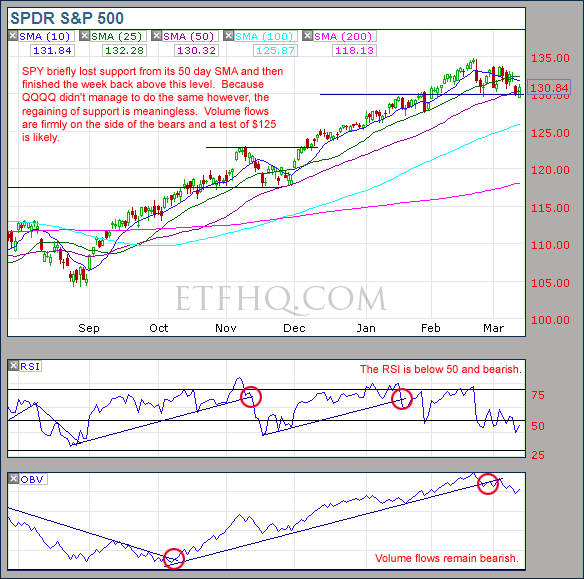
Volume flows have deteriorated and the 50 Day SMA support is meaningless without QQQQ.
.
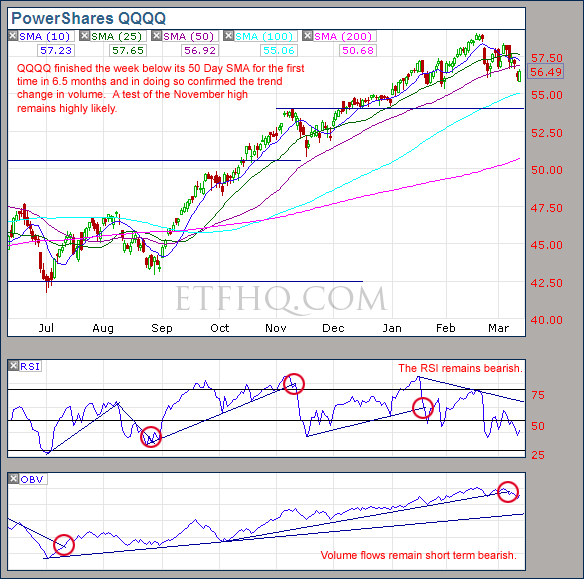
The loss of support confirms the short term bearish trend change in volume.
.
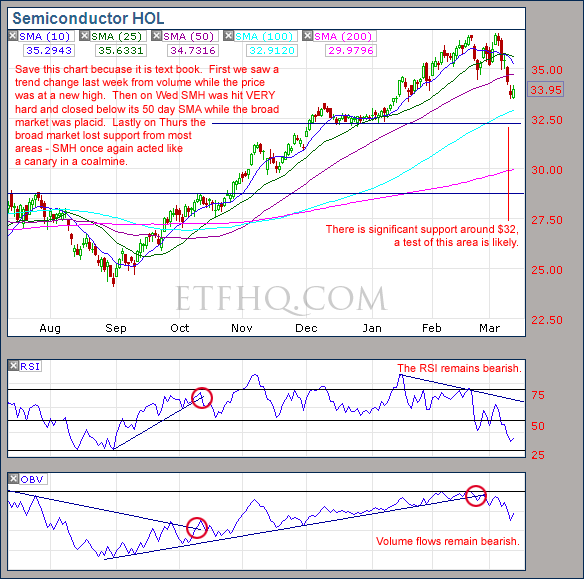
Save this chart it is full of warning signs. Volume has been heavy on the declines.
.
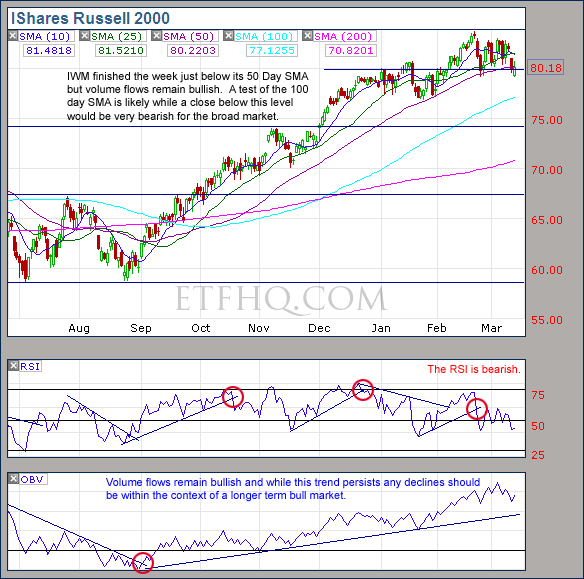
The continued bullish volume trend of IWM offers further hope for the longer term prospects for higher prices.
.
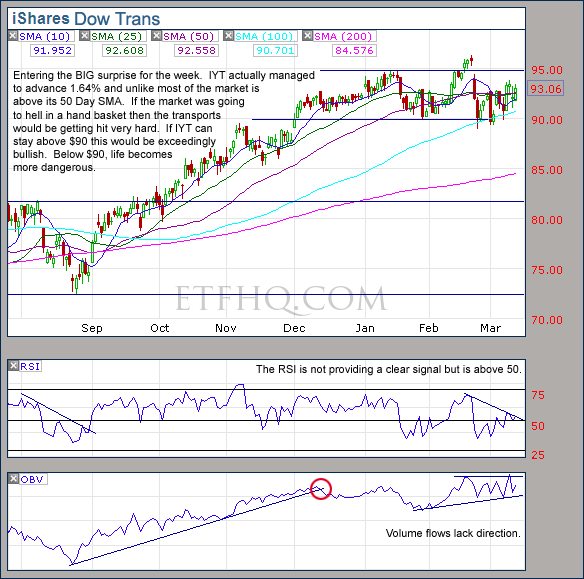
There is no way that a trend change on the broad market can occur while IYT remains above $90.
.
![]()
.
OM3 Weekly Indicator
.

SMH has just recieved the first sell signal from the OM3 indicator in over 6 months. Bear alerts across the board warn of a continued decline in the weekly cycle.
Learn more – The OM3 Indicator
.
![]()
.
TransDow & NasDow
.

NasDow – The Dow remains dominant over the NASDAQ after 91 days during which time the Dow and NASDAQ have advanced 5.56% and 2.96% respectively.
TransDow – The Dow remains dominant over the Transports after 48 days during which time the Dow and the Transports have advanced 1.45% and 1.61% respectively.
Historically when the Dow has been the dominant index the market has been very unproductive and most of its major declines have occurred.
.
What the TransDow Readings tell us:
The TransDow measures dominance between the DJ Transportation Index (DJTI) and the Dow Jones Industrial Average (DJIA). In a strong market the more economically sensitive Transportation Index should be dominant over the DJIA.
Historically the DJTI has been dominant over the Dow 45% of the time. The annualized rate of return from the DJTI during this period was 18.47% with the biggest loss for one trade sitting at -13.27%. The annualized return from the DJIA during the periods it was dominant over the DJTI was just 4.06% and the biggest loss for one trade was -16.13%. A 4% stop-loss is applied to all trades adjusting positions only at the end of the week.
What the NasDow Readings tell us:
The NasDow measures dominance between the NASDAQ and the DJIA. Using the same theory behind the Trans Dow; in a strong market the more economically sensitive NASDAQ should be dominant over the DJIA.
Historically the NASDAQ has been dominant over the DJIA 44% of the time. Taking only the trades when the NASDAQ is above its 40 week moving average the annualized rate of return was 25.47% with the biggest loss for one trade sitting at –8.59%. The annualized rate on the DJIA during the periods it was dominant over the NASDAQ is just 8.88% and the biggest loss for one trade was –12.28%. A 8% stop-loss is applied to all trades adjusting positions only at the end of the week.
.
![]()
.
LTMF 80 & Liquid Q
.
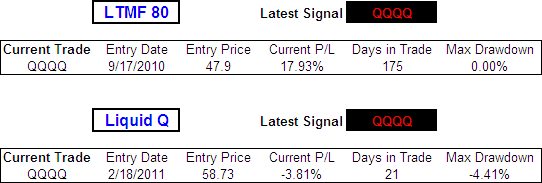
LTMF 80 continues to hold a position in QQQQ that is showing a profit of 17.93% after 175 days. Liquid Q also continues to hold a position in QQQQ that is showing a loss of 3.81% after 21 days.
.
Historical Stats:
.

.
How The LTMF 80 Works
LTMF stands for Long Term Market Forecaster. It reads volume flows relative to price action and looks for out performance of volume measured on a percentage basis over the prior 12 months. During a sustained rally the readings will reach high levels (near 100%) making it imposable for the volume reading to always outperform price so any reading above 80% will maintain the buy signal. This system has outperformed the market over the last 10 years but performance has been damaged by some nasty losses. It only produces buy signals and only for QQQQ.
How Liquid Q Works
Liquid Q completely ignores price action and instead measures the relative flow of money between a selection of economically sensitive and comparatively stable ares of the market. It looks for times when the smart money is confident and and can be seen by through volume investing heavily is more risky areas due to an expectation of expansion. This system has outperformed the market over the last 10 years and remained in cash through most of the major declines. It only produces buy signals and only for QQQQ. We will provide more performance details on the web site for these systems soon.
.
![]()
.
Summary
The Bad – Important support has been lost from many areas and this has been confirmed by a trend change in volume.
The Good – IWM still has a bullish volume trend, SMH was the last to peak before the recent declines and IYT is showing exceptional relative strength.
While the good factors continue to exist it is likely that these declines are simply a healthy pull back within a longer term bull market. This situation is constantly evolving however so please stay alert and don’t go to sleep at the switch in case we start to see a melt down; be it figurative or literal.
Any disputes, questions, queries, comments or theories are most welcome in the comments section below.
.
Cheers
Derry
And the Team @ ETF HQ
“Equipping you to win on Wall St so that you can reach your financial goals.”
.
![]()
.
Angry Degenerate Of The Week:
“listen u *%$@ STOP writin about the stock falling. it criminals like you with your letters that cause the market to go down!!!!!!” – Anonymous Reader
What did you mean by “DANGER, will Robinson!”? Castaway like Crusoe?
Not Castaway but almost. There was a popular TV show in the 60s called ‘Lost in Space’. http://en.wikipedia.org/wiki/Lost_in_Space
The Robot was famous for saying “Danger, Will Robinson” http://www.youtube.com/watch?v=RG0ochx16Dg
Cheers
Derry